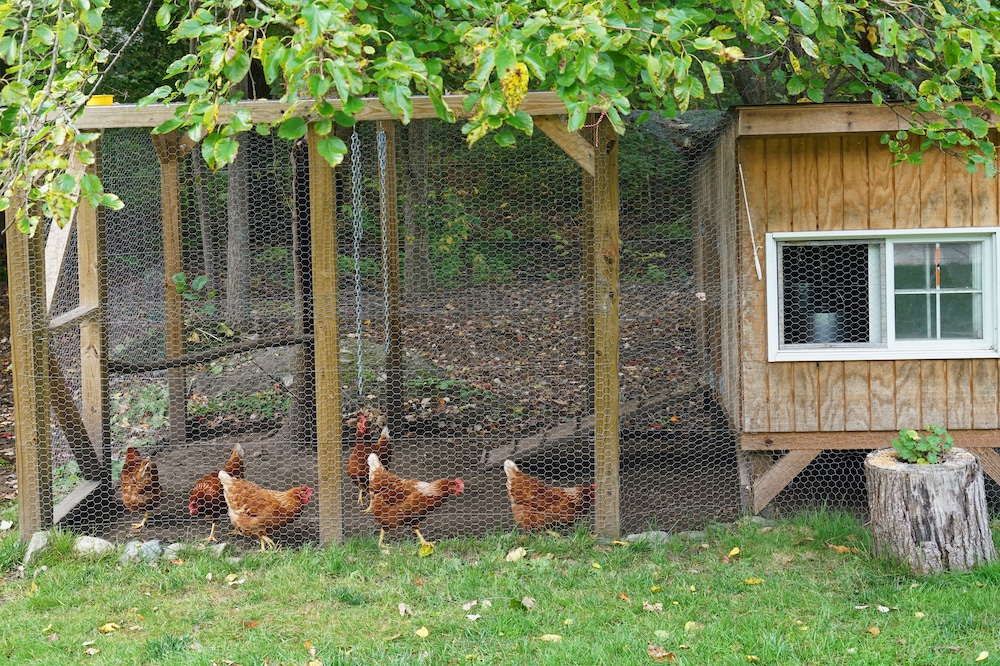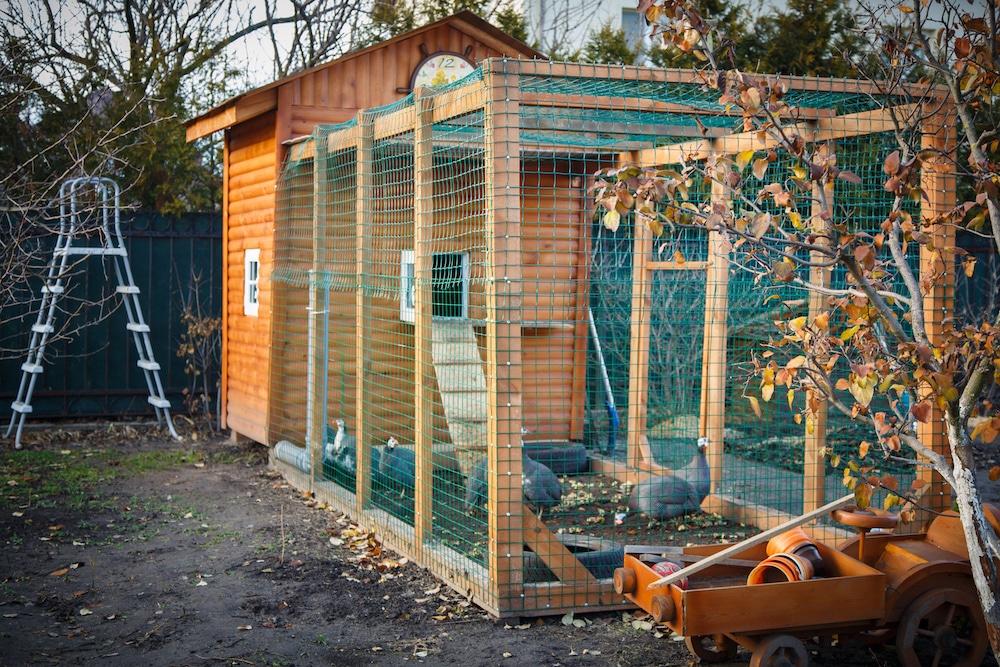If you want to start a small farm, it’s important to ask, “How much does it cost to build a chicken coop?†Not only are chickens a highly productive animal, but they can also make excellent companion animals on your farm. In this guide, we’ll explore all of the costs associated with designing and building your coop.
What Do Chicken Coops Need?
When you’ve decided that you want to create your chicken coop, there are several things you’ll need. This list is essential if you want to build a DIY coop compared to purchasing a prefab design.
Chicken Coop Material
The first thing to consider is the type of material you want the coop to be made from. Several options ranging from mesh to softwood exist, each with its benefits and costs. Let’s consider four of the most popular materials to help get you started.
- Softwood ($2 to $3/Foot)
Softwood is an excellent option if you’re looking to make a budget-friendly chicken coop. Although it’s less expensive upfront, it requires more maintenance than other materials. For example, you’ll need to ensure it’s regularly sealed to protect it from the elements.
It’s certainly possible to create a chicken coop entirely out of softwood, but many also use mesh and plywood. You’ll find the costs for softwood will fluctuate, especially with the current prices of lumber. In a traditional market, you can expect to pay between two and three dollars per foot.
- Corrugated Tin ($15 to $20/Sheet)
Corrugated tin is one of the most popular materials for chicken coops with its durability and resilience. It’s also one of the more expensive materials, outside of mesh, that you can use.
Corrugated tin has special weather protection and helps shield your animals from the elements. You’ll find it’s also relatively easy to work with, especially if you want to make a stable long-term structure. If you’re on a tight budget, consider using this material and less expensive ones for a more structurally sound building.
Corrugated tin makes great walls and is also an excellent option for your coop’s roof.
- Plastic ($25 to $30/Sheet)
If you’re not a fan of metal because it attracts a lot of heat, plastic is another great alternative for your coop. It’s not as popular as others, especially since plastic sheeting can be challenging to source. You’ll find it’s mostly used in prefab coops, but you can easily create your own if you find plastic sheets.
The largest advantage of this material is that it’s incredibly sturdy and weather resistant. You’ll also find it’s easy to work with, as you can quickly assemble your coop using basic screws. You can expect to pay anywhere from $25 to $30 per sheet of plastic on average.
- Mesh ($30 to $40/Roll)
There’s no doubt that mesh is by far one of the most popular materials for chicken coops. Although the entirety of your enclosure shouldn’t be mesh due to its poor insulation, it’s a handy material. You can use it for covering your windows, providing an open roaming space for your chickens, or as parts of the walls.
You must invest in a high-quality mesh that won’t rust over time. Also, you’ll want a thick material to keep your chickens safe from predators overnight.

Chicken Coop Flooring
The second part of your chicken coop that you need to consider is its flooring. Much like a standard home, you’ll want to ensure you have high-quality flooring to keep your animals protected and comfortable.
Let’s take a look at four of the most popular flooring options to pair with your coop.
- Plywood ($10 to $20/Sheet)
Plywood is a fabulous material for flooring since it’s resilient and elementary to work with. You can quickly cut plywood into specific shapes to find the perfect flooring size for your coop. Also, it’s easy to sweep clean when you’re changing bedding materials during your regular maintenance.
However, plywood isn’t the most resilient material when it comes to longevity. The wood will wear down over time, and it’s also known to absorb odors, making cleaning a little more challenging. It’s also important to note that it’s relatively thin, which means predators can chew through it rather quickly.
- Rubber ($45 to $80/Sheet)
Rubber is the second most expensive option for chicken coop flooring, but it’s also a lifesaver. This highly durable material helps keep your chicken’s feet healthy due to its natural cushioning. It’s also straightforward to keep clean, especially when rinsing your coop down to keep it bacteria-free.
The thickness and durability of rubber make it a fantastic barrier from predators, and it’s even comfortable for you to walk on. With that said, the conveniences of rubber are undoubtedly noticeable in its price, as it can cost up to $80/sheet.
- Vinyl ($2 to $8/Square Foot)
The least expensive option for chicken coop flooring is vinyl, a convenient, cost-effective choice. Although it’s inexpensive, you will need to take extra steps to ensure its durability, such as installing a subfloor. This extra step adds to the cost of the material, but on average, vinyl is easy to assemble and easy to clean.
- Concrete ($110/Cubic Foot)
There’s no doubt that concrete is one of the top-tier materials for chicken coop flooring. It’s a great option if you’re creating a high-quality permanent structure since it won’t break down over time. If predators are your primary concern, this material is sure to keep even the smallest pests away.
- Nesting Boxes ($30/Box)
When it comes time for your chickens to lay their eggs, they’re going to need nesting boxes. Typically, nesting boxes are affordable to purchase prebuilt, but you can also consider building your own to save costs. Readymade boxes are likely to cost around $30/box, which isn’t too much of an investment for something your chickens use regularly.
Chicken Roost ($20 to $80)
It’s unlikely your chickens will sleep in their nesting boxes, which is where a roost comes into play. This space is traditionally elevated from the rest of your coop and is used for sleeping.
Depending on how luxurious you want to get, chicken roosts can be standalone structures or simple tree branches. Some of the more elaborate options have multiple levels for chickens to find their ideal resting place.
Most often, you’ll want to make a roost out of wood, whether it be prefab or natural. If you only have a couple of chickens, you can get away with a thick tree branch secured in your coop for sleep.
Other Costs To Consider
Outside of the basic costs for building a chicken coop, there are a couple of extra items to consider. These additions can vary in how expensive they are, depending on how you build them.
Dust Bath
Dust baths are helpful for your chickens to be able to roll around in the sand or dry dirt. Depending on the material you choose for their dust bath, the costs can vary. You’ll also need to consider the cost of the container you choose to hold the dirt or sand.
Ventilation
Making sure your coop has plenty of ventilation is important, especially in the summer. The most popular option is to plan to have windows in your coop for free ventilation. You’ll need to factor in the costs of protecting your windows with mesh as well as any extra ventilation equipment, like fans.
Chicken Maintenance
Taking care of your chickens and ensuring they have a healthy diet is of the utmost importance. At this point, you’ll need to consider the costs associated with owning animals. These expenses could include veterinary visits, food, water, and clean bedding.
How Much Does It Cost to Build a Chicken Coop: Final Thoughts
Answering, “How much does it cost to build a chicken coop?†takes a lot into consideration. From the type of flooring to how you construct their roost, there are several items you’ll need. By making a list of the largest expenses, you can prepare your budget for the best possible coop for your animals.
Contents

